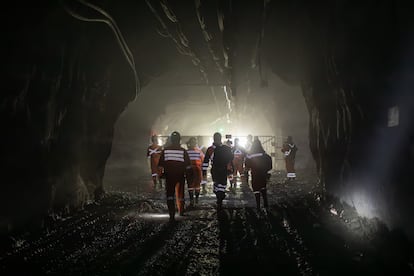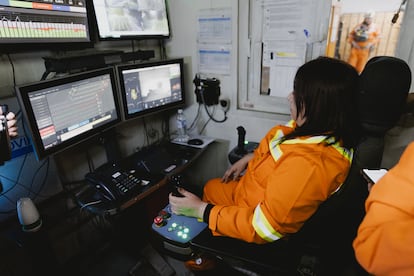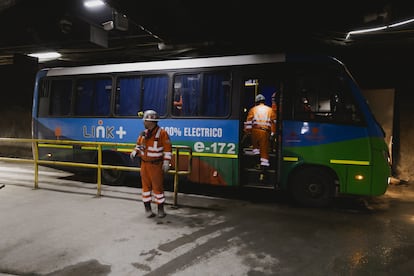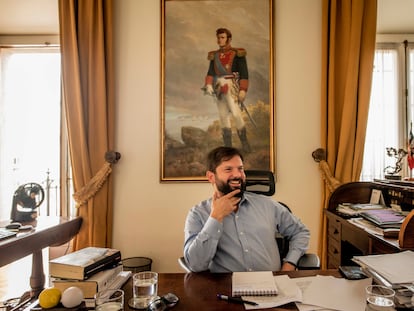A trip to El Teniente, the largest underground copper mine in the world
The red metal deposit located in the Chilean region of O’Higgins, which is controlled by the state copper company Codelco, is moving towards green mining: it reuses tires and uses 100% electric buses


Just over 30 miles east of the city of Rancagua, in the O’Higgins Region in central Chile, after traveling a zigzagging road with the semi-white hills of the Andes mountain range as a backdrop, you reach El Teniente, the largest underground copper deposit on the planet. The mine, which has 2,800 miles of underground tunnels, is controlled by the state copper company Codelco, the largest copper supplier in the world.
From the surface, with wind blowing relentlessly, it is difficult to imagine the bustling world under the 2,200-meter-high hill, which began to be mined in 1905. From El Teniente, around 350,000 fine metric tons (ft) of copper are mined each year: it is the Codelco division that provides the largest contribution of the red metal.
Although the Chilean company remains a global leader it produced 1,324,554 fine metric tons (ft) of copper in 2023, a drop of 8.4% compared to the previous year, amid interruptions in the mines and delayed projects due to the systemic lack of investment.
Today, Codelco wants to increase its production through an injection of $40 billion over the next 10 years — a plan that will also involve reviewing the aging deposits.

The company also has its sights set on greener mining and aims to reduce its carbon footprint by 70% by 2030 and achieve carbon neutrality by 2050.
The CEO of the state copper company, Rubén Alvarado, says that they do not see “a conflict between sustainability and productivity.” He explains that the markets are demanding mining companies have environmental certifications and that Codelco considers them a “fundamental asset.”
Through the underground cities of El Teniente, in a darkness that seems to have no end, 100% electric buses travel to take the miners to their workplaces. They currently have 104 vehicles, and it is one of the largest electric fleets in the world in mining operations.
These vehicles are manufactured on the outskirts of the city of Rancagua by Reborn Electric Motors, the first and, so far, the only Chilean company that makes electric buses. Ricardo Reppening, one of its founders and current technology manager, says that “mining made the company possible.”
Nine trains, also 100% electric, travel through the different mining stations at around 21 miles per hour. This 20-mile railway line, which is remotely coordinated from Codelco’s Integrated Operations Center (CIO) in Rancagua, is the mine’s largest asset.

Not only are the trains coordinated outside of the mine, but many of the machines used to drill the rocks are also automated. Sitting in a chair with controls inside one of the offices in the underground mine, Liliana Rodena, a 46-year-old operator at El Teniente, explains how things have improved while moving controls and looking intently at the screens: “Before, one was exposed to a lot of dust and noise [...] Through these remote-controlled devices, the quality of life has completely changed.” Liliana, who has been working in mines for 12 years, says that automation has allowed more women to enter the industry. In terms of gender parity, women made up 16.6% of Codelco’s total workforce in 2023. The goal is to reach 35% by 2027.
Along the labyrinth of underground paths in El Teniente, there are about 40 recycling points divided into plastics, textiles and leather. In that last container, dozens of shoes worn by time and dust are piled up. Recycling does not only occur on a small scale, because if there is one thing that is abundant in the mines, it is wheels. Through an alliance with the company Arrigoni Ambiental NFU, located 13 miles from Rancagua, used tires are recycled.

In 2023, 5,500 tons of tires were processed at the plant, 50% of them from the mining industry, with Codelco its main supplier. Through a chemical process called pyrolysis (the thermal decomposition of substances when they are heated to high temperatures and in the absence of oxygen) they obtain three reusable by-products: steel, coal and an alternative fuel to diesel.
Mauricio Bravo, the deputy manager at Arrigoni Ambiental NFU, explains that the process carried out at the plant is “true circular economy”: “We seek to ensure that the products obtained from the pyrolysis of tires can be used in the same industry that generated them.”
In the case of mining, Bravo points out that they use steel to manufacture industrial floor grills. “We transform the coal into activated carbon to filter mineral-rich waters, such as those found in mines. And, for the alternative fuel to diesel, we look beyond its calorific property value and see its application as an additive for mining processes.” He adds: “That is what would allow us to have 100% of the products used in the industry that provided us with the tire and not have to worry about another environmental liability.”
For Rubén Alvarado, CEO of Codelco, these types of alliances are what will allow Chile to move towards “leading responsible mining.”

Sign up for our weekly newsletter to get more English-language news coverage from EL PAÍS USA Edition
Tu suscripción se está usando en otro dispositivo
¿Quieres añadir otro usuario a tu suscripción?
Si continúas leyendo en este dispositivo, no se podrá leer en el otro.
FlechaTu suscripción se está usando en otro dispositivo y solo puedes acceder a EL PAÍS desde un dispositivo a la vez.
Si quieres compartir tu cuenta, cambia tu suscripción a la modalidad Premium, así podrás añadir otro usuario. Cada uno accederá con su propia cuenta de email, lo que os permitirá personalizar vuestra experiencia en EL PAÍS.
¿Tienes una suscripción de empresa? Accede aquí para contratar más cuentas.
En el caso de no saber quién está usando tu cuenta, te recomendamos cambiar tu contraseña aquí.
Si decides continuar compartiendo tu cuenta, este mensaje se mostrará en tu dispositivo y en el de la otra persona que está usando tu cuenta de forma indefinida, afectando a tu experiencia de lectura. Puedes consultar aquí los términos y condiciones de la suscripción digital.
More information
Archived In
Últimas noticias
There is as much life left to discover on planet Earth as that which is already known
Dozens presumed dead, around 100 injured in fire at Swiss Alps bar during New Year’s celebration
Is porn for women different from conventional porn? We spoke to those who make it
Cartagena de Indias is sinking: What can the city do to mitigate it?
Most viewed
- Reinhard Genzel, Nobel laureate in physics: ‘One-minute videos will never give you the truth’
- David King, chemist: ‘There are scientists studying how to cool the planet; nobody should stop these experiments from happening’
- Oona Chaplin: ‘I told James Cameron that I was living in a treehouse and starting a permaculture project with a friend’
- Sinaloa Cartel war is taking its toll on Los Chapitos
- The Interoceanic Train, the Mexican alternative to the Panama Canal










































